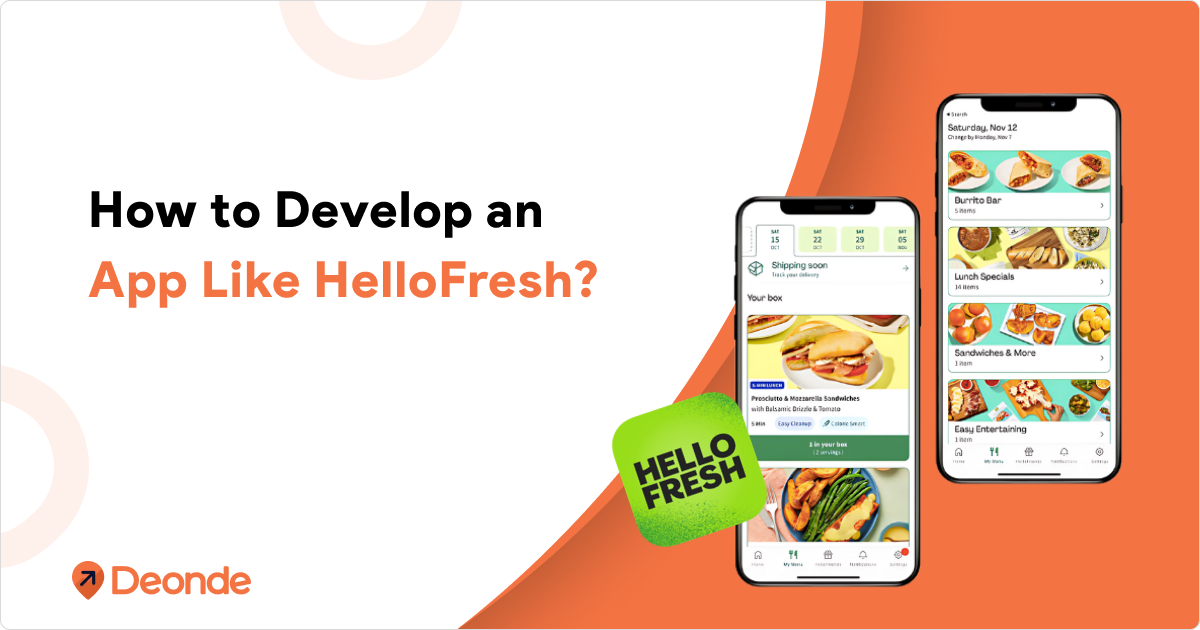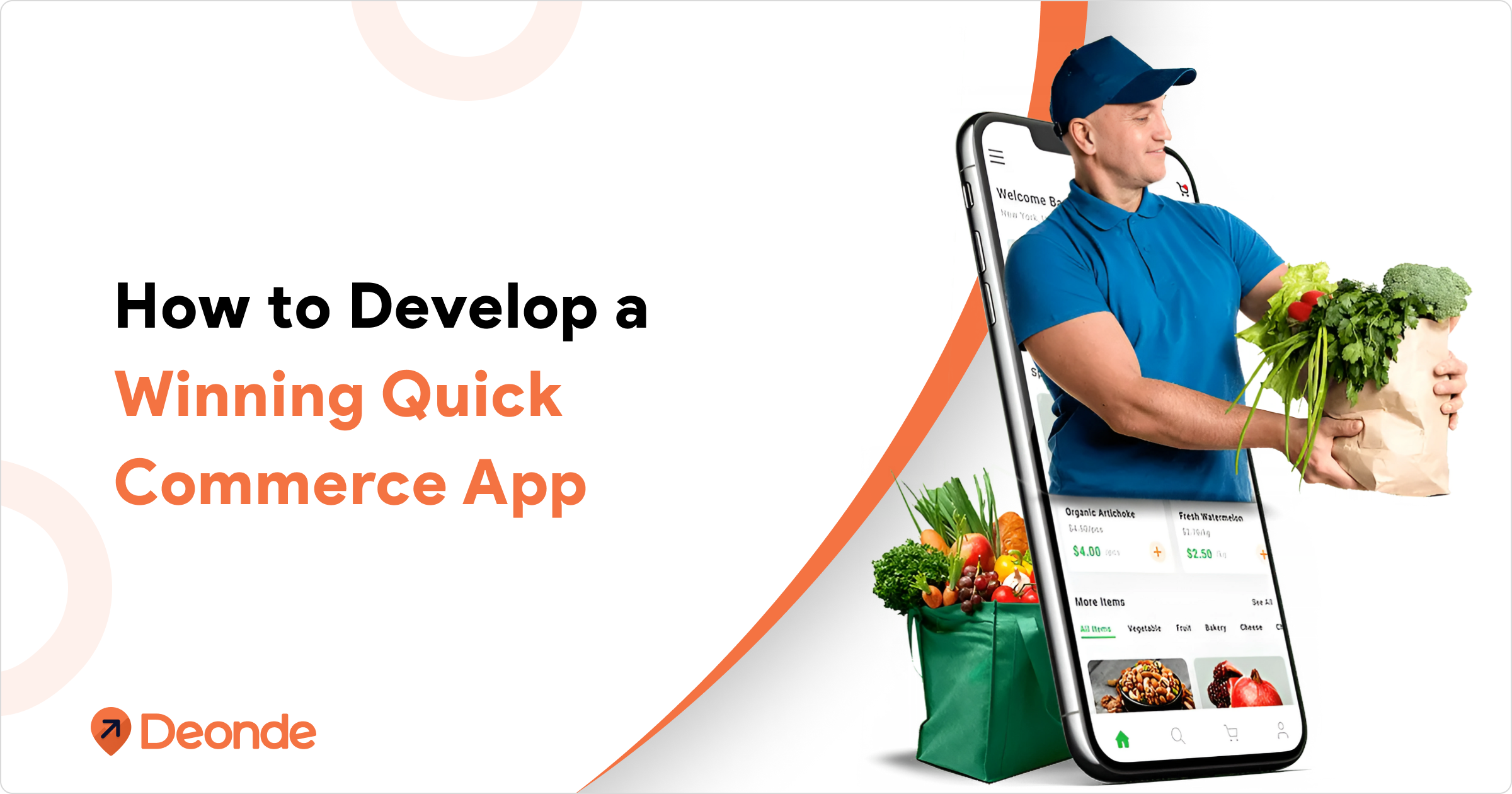Online grocery delivery businesses have skyrocketed, especially after the pandemic.
As a result, supermarkets and e-commerce players have focused heavily on strengthening their online delivery chains and workflows.
Online SaaS-based grocery apps, in particular, have seen an increase in usage across the global markets.
These apps have enhanced user convenience, enabling them to receive orders at the click of a button. As more customers opt for doorstep delivery, the demand for these online grocery delivery apps has increased.
As a result, the scope of developing grocery delivery applications across mobile operating systems has also broadened.
In this blog, we’ll uncover the workings, advantages, and a few examples of some of the best online grocery delivery apps in the United States.
So, let’s get started.
How Does An Online Grocery Delivery Business Work?
The on-demand grocery business has been tremendously successful because of widespread accessibility and convenience.
The on-demand grocery delivery model allows retailers and wholesalers to cater to a vast online market.
This business model comprises grocery retailers, app users, and delivery partners. The grocery delivery platform serves as an intermediary between them.
Typically, the grocery delivery platform establishes partnerships with various retailers, from large chains to local stores. These partnerships involve agreements on pricing, product availability, delivery zones, and commission structures.
These retailers are also responsible for preparing orders for pickup once a customer orders through the platform.
On the other hand, customers use the grocery delivery mobile app to browse available stores, select items, and place orders.
The app displays product details, pricing, and estimated delivery times. Then, customers make payments securely through the app using various digital methods. Customer app Features like real-time order tracking keep customers informed of their order’s status, and the app facilitates communication with the delivery partner or retailer if needed.
Lastly, delivery partners pick up prepared orders from retailers and deliver them to customers’ doorsteps. The grocery delivery app also provides navigational cues to ensure efficient deliveries.
The key to success in this business lies in providing customers with reliability, convenience, and ease of use.
Now that you know about the working model of an online grocery delivery business, let’s talk about who makes up our list of the Best Online grocery delivery apps in the USA.
Top 10 Grocery Delivery Apps in the USA

1. Instacart

Instacart is one of the most preferred grocery delivery apps in the USA. Their well-spread delivery network covers almost 85% of the US and nearly 70% of Canada.
Instacart’s tie-ups with grocery giants like Whole Foods, Costco, Safeway, and several others have helped them deliver over 300,000 items.
They have partnered with more than 25,000 stores and raised 6 rounds of funding. Notably, Instacart was valued at $9.3 billion by the end of 2023.
Instacart’s success lies in its customer-centric approach. Incentives, like free deliveries, help Instacart stand out from the rest.
Additionally, their partnerships with a majority of US grocery giants allow customers to buy groceries from multiple stores. Hence, Instacart users can compare prices from multiple stores and make smarter purchases.
Along with this, features like multiple discounts, offers, and a membership option further help them penetrate the market.
2. AmazonFresh

Introduced by Amazon, this on-demand grocery delivery service is offered as an extension to the Amazon Prime membership.
Currently, AmazonFresh is offering its grocery deliveries to existing Prime members.
Apart from groceries, they also deal with products like fruits, vegetables, canned goods, and many more. In addition to this, they deliver household supplies like batteries, paper, and cleaning products to name a few.
Some of the cities where their services are available include Brooklyn, Indianapolis, Nashville, Seattle, and Las Vegas.
For Prime members, free delivery is provided in case of orders exceeding $35. For orders less than $35, a delivery fee of $10 is charged.
In some cities, like New York, the minimum delivery amount for free delivery is above $35.
3. FreshDirect

As the name implies, FreshDirect focuses on providing fresh products to its customers.
Their target audience consists of people who are conscious about what they consume and where the deliverables are sourced from.
Founded in 1999 by David McLnerney, FreshDirect has been serving several northeastern US cities. Some of them include New Jersey, New York, Pennsylvania, Washington, and Delaware.
A majority of their farm-fresh products come with information mentioning brief details about their source.
The delivery fee for an order varies as per the location of the customer, with a general charge ranging from $6 to $30.
Since the company focuses on providing farm-fresh products, the time of delivery is not immediate but fast enough to help them retain customers.
4. Kroger
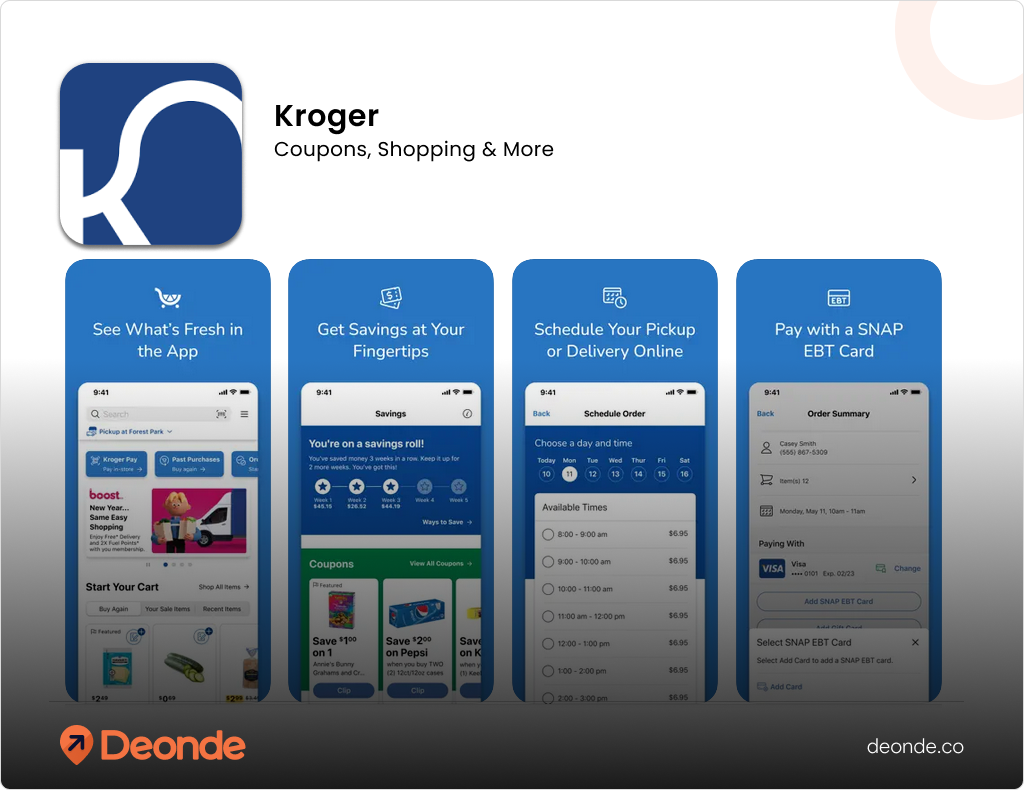
Kroger is also an on-demand grocery delivery app that operates in the USA across 35 states with more than 2800 stores and 24 regional chains.
The app delivers fresh groceries at competitive prices, making it a go-to app for families and individuals alike.
With quality and affordable services, they have created a unique niche for themselves within the on-demand grocery space.
At just $6.95, customers can get their groceries delivered to their place through a third-party partner.
Kroger partners with farmers to deliver fresh produce to their customers. With customer-centric offers like exclusive deals, discounts, and loyalty programs, Kroger ranks as one of the best on-demand grocery delivery apps.
5. Safeway
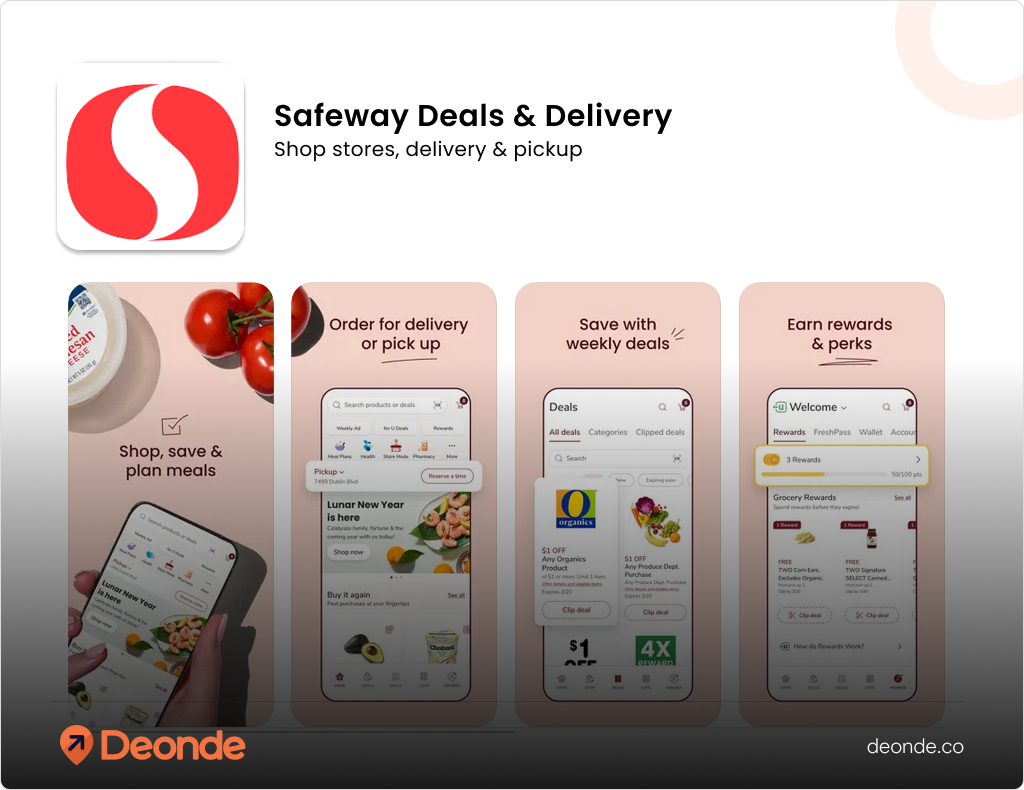
Safeway’s position as a leading North American grocery chain, with over 924 stores across the US, provides a strong foundation for its grocery delivery app.
Safeway already possesses a vast network of physical stores, which serve as distribution hubs for their grocery delivery service.
This eliminates the need to build separate warehouses or fulfillment centers, significantly reducing startup costs and logistical complexities. Each store can act as a micro-fulfillment center, serving customers within its surrounding radius.
Safeway’s long-standing presence and established brand recognition give them a significant advantage in attracting customers to their grocery delivery app.
Consumers are already familiar with the Safeway brand and likely have a level of trust in the quality of products and services they offer.
By offering a convenient and reliable grocery delivery service, Safeway can compete effectively with other grocery chains and third-party delivery platforms.
6. Walmart Grocery Delivery
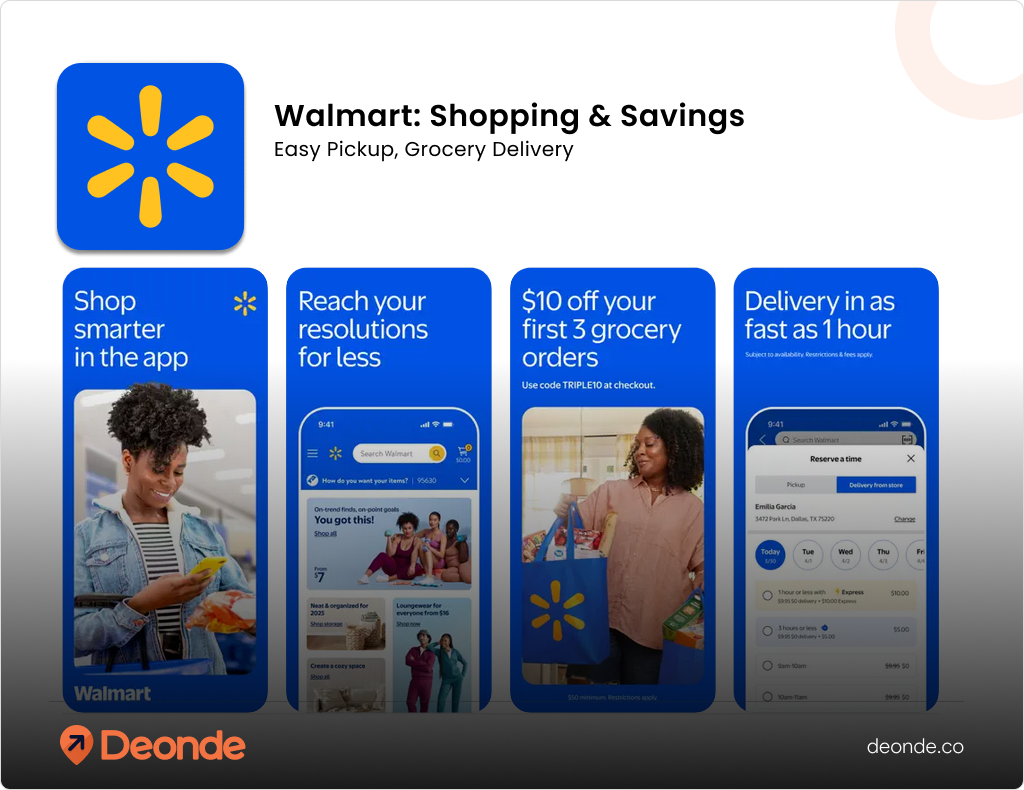
Walmart’s grocery delivery app seamlessly integrates with its extensive network of retail stores, effectively extending the store aisles to customers’ homes.
The Walmart grocery delivery app offers a wide selection of products, mirroring the in-store inventory, and lets customers browse and buy groceries for home delivery.
Customers gain further control over their shopping experience by selecting preferred delivery time slots, though a standard delivery fee of $8-$10 applies per order.
For frequent users, Walmart provides a cost-effective subscription model at $13 per month or $100 annually, unlocking the benefit of unlimited free deliveries.
This service underscores Walmart’s commitment to providing instant grocery delivery, prioritizing convenience and accessibility for its customers.
7. Shipt

Shipt With over 50,000 shoppers and an estimated annual revenue of $1 billion, Shipt is a leading online grocery shopping app. It has partnered with major retailers like Target, Whole Foods, Publix, and many more.
A workforce of over 5211 employees allows them to provide the best grocery delivery services to their customers.
Shipt offers unique features, including the facility to browse sale items and request products not listed in stores. Its ‘Buy Again’ feature allows users to repurchase previously ordered items, making weekly grocery shopping more convenient.
The app can be accessed with a $15 monthly fee or a $99 annual membership fee.
8. DoorDash
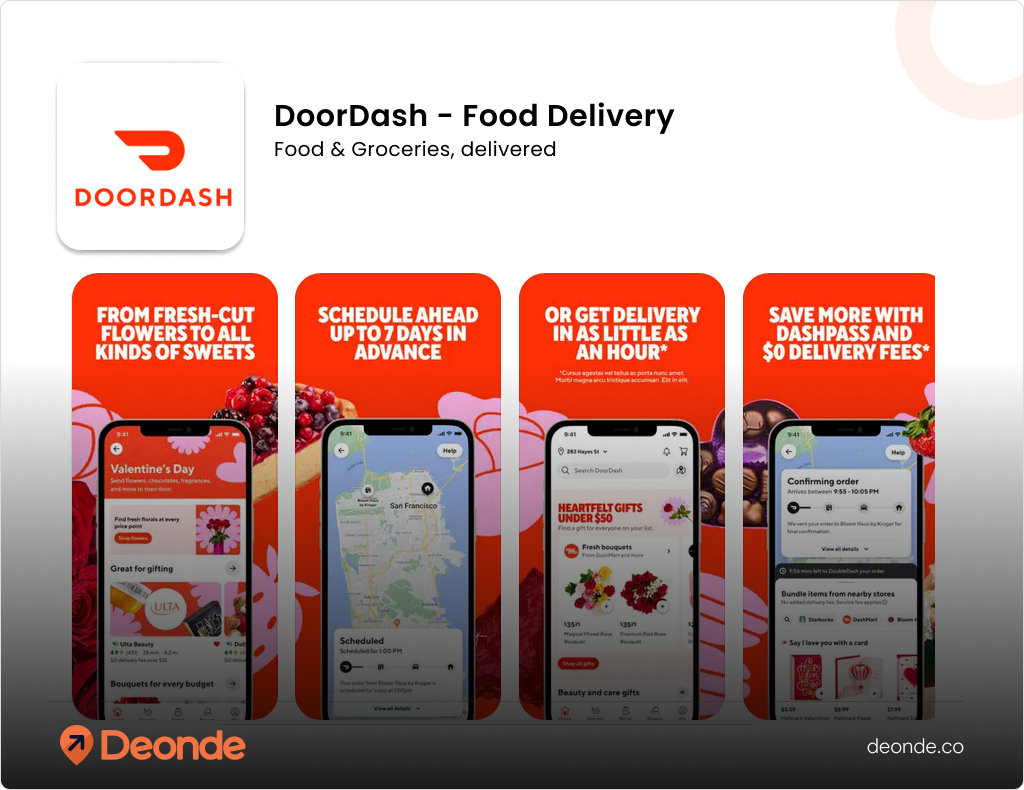
Doordash is arguably one of the best online grocery delivery apps the USA market has seen.
It is a popular food ordering platform that also delivers essentials, snacks, beverages, and household items.
Along with Dashmart, it offers a fast and convenient shopping experience, often delivering orders within minutes.
By delivering items like groceries, personal care products, cleaning supplies, and pet food, they help get rid of traditional grocery shopping.
To further enhance the user experience, DashPass members get free delivery and are charged lower service fees on orders over $12.
9. Peapod

Based in Chicago, Peapod is one of the most preferred grocery delivery apps in the USA.
Currently, they offer groceries in more than 24 US markets, including the likes of Washington, Boston, New York, and many more.
Peapod simplifies grocery shopping with features that enhance convenience. “Order Genius” and similar options help users track past purchases and receive relevant product suggestions.
The app’s smart algorithm tailors search results to customer needs. To add to this, a service like meal kits allows customers to buy all the items required to make particular dishes.
10. GoPuff
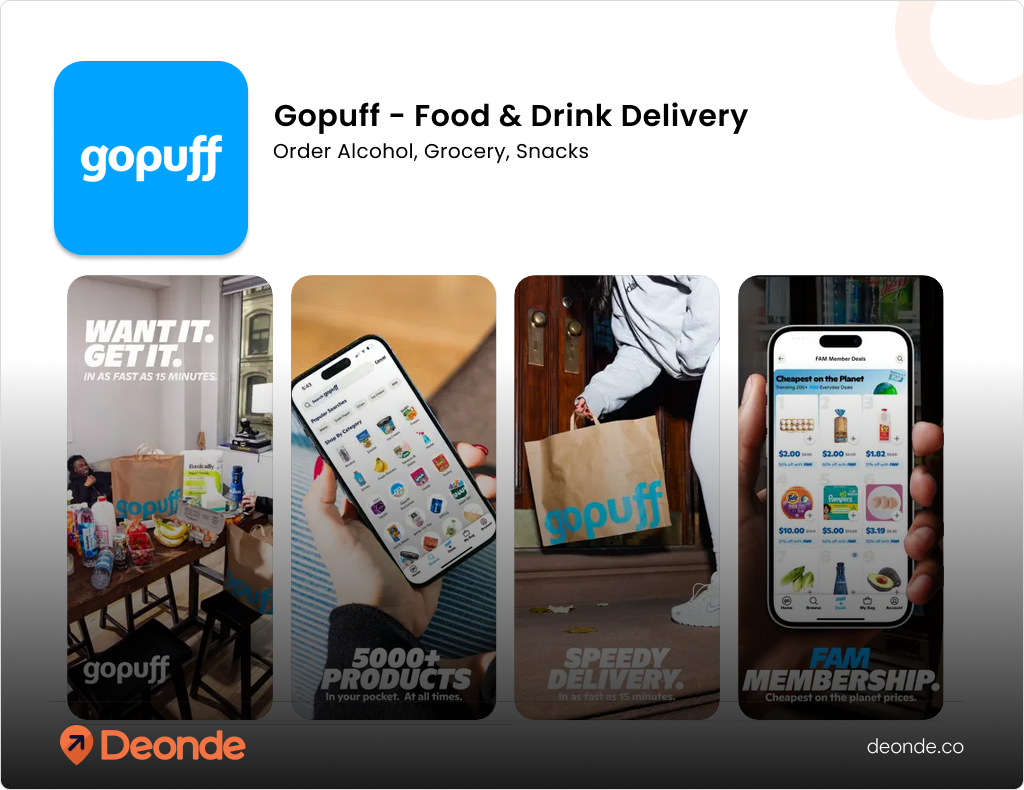
GoPuff is a rapid grocery delivery service that focuses on delivering everyday essentials and convenience items to customers’ doors in minutes.
It operates by establishing its micro-fulfillment centers in various locations. Customers can order through the Gopuff mobile app, and these deliverables are picked up by Gopuff’s own employed drivers.
This vertically integrated approach allows GoPuff to control its inventory and delivery process, aiming for speed and reliability.
While initially focused on a smaller selection of items, GoPuff has expanded its offerings to include groceries, alcohol, prepared foods, and even some over-the-counter medications in certain markets.
The company’s business model relies on quick delivery and a convenient user experience, often targeting a demographic willing to pay a premium for immediate gratification.
While GoPuff has faced challenges related to profitability and competition in the crowded rapid delivery space, it continues to remain a significant player in the on-demand grocery delivery market.
Cost Of Developing An Online Grocery Delivery App
The cost of building a grocery delivery app depends on several key factors.
Hence, it’s crucial to start by clearly defining your app requirements, features and functionalities, design, tech stack, and other elements.
While developing from scratch has its own merits, partnering with a reputable grocery delivery app development company like Deonde is the easiest way to get started with your own on-demand grocery delivery app.
Here’s the cost of developing an on-demand grocery app from the ground up:
|
Country/Region |
Avg Developer Hourly Rate Starts from (USD – Approximate) |
|
India |
$30 – $60+ |
|
Eastern Europe |
$60 – $100+ |
|
U.S.A |
$70 – $150+ |
A typical grocery delivery app involves four different types of apps: A user-facing app, a Delivery driver app, a Retailer/Seller app, and an Admin app.
These apps often have features like real-time tracking, push notifications, and rating/review systems, contributing to the development time and cost.
Based on the complexity of your app, your developer might take up to 2000+ hours to deliver your grocery delivery app.
|
Application Type |
Estimated Development Time (Hours) |
|
Simple App |
600 – 900 |
|
Mid-Level App (with advanced features) |
1600+ |
|
Comprehensive Grocery Delivery App (customer, delivery, store, & admin) |
Up to 2000+ |
With these figures in mind, it’s best to work with an established SaaS-based grocery delivery app development company like Deonde.
With Deonde, you can sign up, log in, and start scaling your grocery delivery business.
Why put yourself through the painful process of developing an advanced grocery delivery mobile app from scratch when you can use Deonde’s SaaS-based grocery delivery suite on the go?
Try Deonde today and see how working with an advanced SaaS-based grocery app feels.
Key Advantages Of Using Deonde’s White-Label Grocery Delivery Solution
- Faster Time to Market: Launch your app in weeks or months, not years.
- Reduced Development Costs: Avoid the hefty expenses of custom app development.
- Proven Technology: Benefit from a platform that’s already been tested, used, and refined by customers across the globe.
- Customization Options: Tailor the app to your specific branding and business needs.
- Focus on Core Business: Concentrate on building your brand, marketing, and customer acquisition, rather than technical development.
- Scalability: Easily scale your operations as your business grows.
Final Thoughts
The online grocery delivery market is experiencing explosive growth, driven by changing consumer habits, increased convenience demands, and tech advancements.
This rapid expansion presents a significant opportunity for entrepreneurs and investors looking to enter a dynamic and profitable industry.
By launching your own grocery delivery app, you can directly enter this market and capture a share of the expanding customer base.
However, building a successful grocery delivery app from scratch can be complex and time-consuming. It requires significant investment in development, design, infrastructure, and logistics.
This is where white-label solutions like Deonde’s offering become invaluable.
Deonde’s white-label grocery delivery app provides a cost-effective and efficient way to launch your own branded grocery delivery service.
Instead of starting from scratch, you leverage a pre-built, customizable platform with essential features and functionalities.
This significantly reduces development time and costs, allowing you to get your business up and running much faster.
FAQs:
1. What is the Most Used Grocery Delivery App in the USA?
Instacart is said to be considered one of the most popular and widely used grocery delivery apps in the USA. It leverages a vast network of retail partners, including major grocery chains like Whole Foods, Kroger, Costco, and many more. Instacart’s ease of use, extensive network, and rapid delivery options have contributed to its significant market share in the States.
2. What Makes Instacart a Popular Choice For Grocery Delivery?
Instacart’s popularity in the United States stems from its extensive network of retail partner stores. As a consequence, it has a wide product selection that can cater to multiple consumer segments. Besides, it also has a user-friendly interface and advanced features like price comparison and personalized recommendations.
3. What Is a White-Label Grocery Delivery App?
A white-label grocery delivery solution is a pre-built, customizable app platform allowing you to launch your branded grocery delivery service quickly and cost-effectively without developing it from scratch.
4. What Are The Advantages Of Using A Grocery Delivery App?
Grocery delivery apps offer numerous benefits, including the convenience of shopping from home, time savings, saving you from making numerous trips to the store, a wider selection of products, price comparison, finding the best deals, and often faster delivery than traditional shopping.



